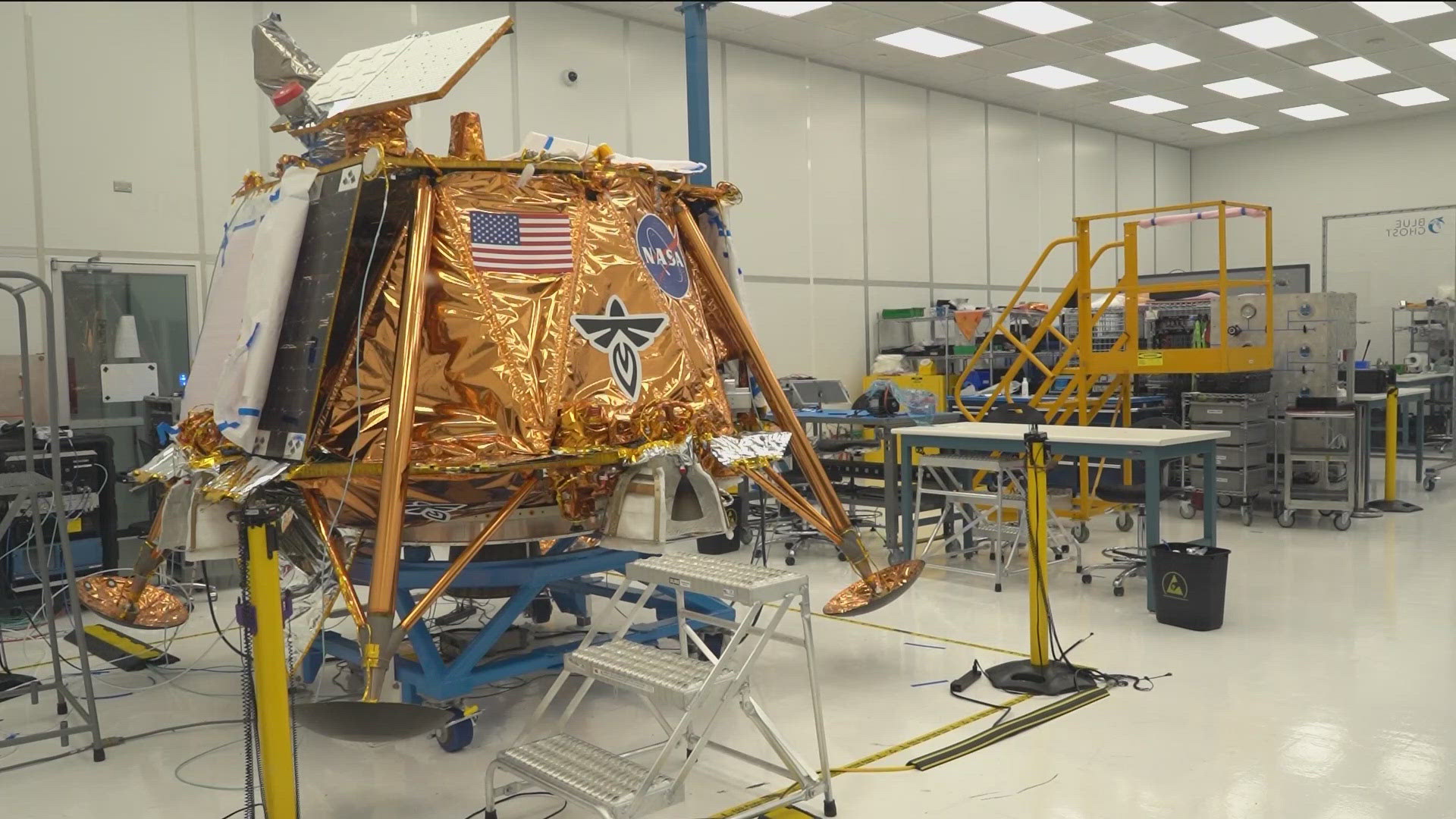AUSTIN, Texas — A Cedar Park company is one step closer to reaching the moon.
Firefly Aerospace said its Blue Ghost lunar lander completed rigorous testing at NASA's Jet Propulsion Laboratory in California in October.
Testing included simulated extreme conditions that Blue Ghost would face during launch, transit, and mission. The lander passed tests for temperature, vibration, acoustics and electromagnetic compatibility.
"We completed environmental testing, and that means that we are ready to launch and survive the mission," Annie Vo-Cohen, an assembly integration and test engineer and mission director, said. "Environmental testing recreates all of the conditions of the mission so that we can be confident in our system and our lander to make sure that she could survive the journey to the moon."
The lunar lander is at the company's Cedar Park facility before it heads to Cape Canaveral in mid-December. Engineers are going over the lunar lander to ensure it is ready for its journey.
"The final stages before we ship is to finalize any components, verify everything is in good shape, verify the pieces are where they're supposed to be and are in working condition and are running as expected," Vo-Cohen said. "Just a lot of verification processes and verifying requirements and testing to make sure it is ready to go to get to the moon."
The hope is to launch the lunar lander on a SpaceX Falcon 9 rocket during a six-day window that opens in January 2025. After launch, Blue Ghost will separate from the SpaceX rocket and begin a 45-day journey to reach the moon.
"Then we start getting our data down, and we start seeing telemetry, and we start doing our maneuvers to get to the right orbits and inclinations," Vo-Cohen said. "Then we do different trajectories to get to the moon, and then we'll orbit the moon and hopefully land softly."
The lunar lander will spend one lunar day or 14 earth days performing experiments that include drilling, dust mitigation and X-ray imaging of Earth's magnetic field. It also hopes to capture data during lunar sunset for future moon missions.
"We have 10 NASA payloads that are on our lunar lander that we're going to deliver to the lunar surface," Vo-Cohen said. "They're going to be doing science and delivering that data back to NASA for future manned and unmanned missions for the Artemis program."
The ultimate goal for NASA involves larger crafts and human missions.
"What this nation wants to do is to be able to establish a near-permanent presence at the moon, whether through humans or robots or other enabling technologies," University of Texas Aerospace Engineering Professor Maruthi Akella said. "Going to the moon is not just a destination, but it's what's in between Earth and Moon, which is this vast region that is extremely complex for operating space flights for long durations."
Akella said these are the very early stages and building blocks of making that happen.
"A lot of things still need to be done in terms of understanding how we can build habitats and how humans can perform and function in those extremely harsh environments for long durations, but these are all the enabling missions that we can we can start going there and start doing so in a safe way and at a cost that we can afford," Akella said.
For Vo-Cohen and the team, the idea of going back to the moon and the possibilities that data collected and research conducted on missions like the one this lunar lander is about to set out on is exciting.
"It's just a space exploration excitement. We get to do more and go to the moon and then to Mars or Jupiter," Vo-Cohen said. "We can learn so much from just starting with just getting out to the next planetary body outside of Earth. So we start there, and then we can still extend further out so that we could send more components over to the moon and see what we could go further."
The space economy has been booming in Texas over the last few years, led by companies like SpaceX and Blue Origin. The Austin area has a handful of companies that work in space-related fields, including Firefly Aerospace.
As for why Central Texas is primed for many of these space companies, Akella said the availability of aerospace engineering students at UT Austin, combined with access to manufacturing and technology like semiconductors and chips, and capital are a big part of it.
The state recently created the Texas Space Commission and invested $350 million to foster more businesses involved in space technology in Texas.
For Vo-Cohen, who has been on the lunar lander team since a few months after they were awarded the contract in 2021, it has been quite the journey.
"Coming from the rocket side and seeing it from the beginning, early concepts of drawings and component testing to verify that our ideas are going to work in our lander is incredible," Vo-Cohen said.
Firefly has also been working on a long-term project to build a rocket that will head to the moon. The company has been doing engine testing about 30 miles north of Leander with the hopes of launching by 2026. That's when they have another NASA mission to the far side of the moon slated for then.

